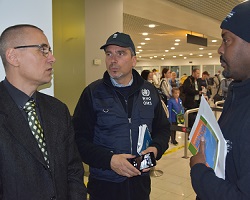Coronavirus disease (COVID-19): European Region focusing on readiness

WHO
In response to the detection of the COVID-19 virus in China in December 2019, countries in the WHO European Region have been activating national plans to ensure that health and other systems are not just prepared for but also ready to respond to importation of this new virus. This means that public health officials can rapidly respond to reports of suspect cases and identify contacts at high risk; hospitals have the necessary equipment and guidance to manage cases while protecting health-care staff and other patients from infection; and the public understands the level of risk posed by the virus and how to minimize it.
Global and regional implementation
WHO works continually with countries to maintain and improve their national preparedness plans based on an all-hazards approach. This collaboration has facilitated rapid action and an effective transition from preparedness to active readiness for importation of the COVID-19 virus. WHO/Europe has surveyed the needs in countries and adapted and disseminated a readiness checklist to ensure the emergency response system is ready. It is facilitating laboratory detection, providing hospital preparedness guidelines and expertise to countries, and is providing technical support to strengthen surveillance systems and infection prevention and control.
WHO and health authorities in countries are facilitating a steady stream of information through regular reporting, daily situation reports, social media posts, briefings and interviews to the media, expanded website coverage, and videos and infographics. WHO is also engaging with social media companies to help disseminate WHO advice and reduce the risk posed by the spread of misinformation.
Subregional hubs
To bring technical support closer to countries in the European Region, WHO teams for emergency preparedness and response support, in 3 geographic hubs, have been strengthened. These hubs, located in the Balkans, south Caucasus and central Asia, now have laboratory and hospital preparedness experts, and specialists in operation planning for emergency response. Additional technical support is being provided by WHO/Europe. The expanded hub teams will enhance the work being done by national authorities at country level and provide surge support where needed.
On 6 February 2020, members of the hub team in Belgrade, Serbia, joined the Serbian Ministry of Health and the Institute of Public Health on a visit to the international airports in Belgrade and Nis, and to the Clinic for Infectious and Tropical Diseases at the Clinical Centre Serbia. The visit provided a better insight into the measures already taken for early detection and prevention of spread of the COVID-19 virus. The joint delegation observed and discussed all measures taken at the points of entry, including temperature screening on entry, appropriate management of suspected cases and dissemination of risk communication materials advising inbound travellers on when and where to seek medical care if needed.
The team found the clinic to be ready and well equipped, with dedicated and experienced medical staff to manage any patient infected with the COVID-19 virus. During the visit, WHO provided technical guidance to support the measures that are already in place.
Applying lessons learned
Some countries in the Region have already experienced importations of the COVID-19 virus and small clusters of cases. Many countries identified suspected cases that were later shown to be negative for the virus. Each suspected or confirmed case tests the country’s response system, providing the opportunity (through ‘after action reviews’) to identify where further improvements can be made. For example, was there any point at which an infected person could have transmitted the virus to others? Were staff and patients given up-to-date instructions? Is contact tracing functioning optimally? As the COVID-19 situation evolves, lessons learned and information sharing at all levels will continue to improve the Region’s defences.
Action at country level: Albania
Albania finalized a new Ministry of Health Emergency Operation Plan in October 2019. This plan was intensely tested in November 2019 when the country was struck by a large earthquake. Based on a thorough review of all response areas, including surge capacity at hospitals and interactions between emergency services and the health system, the plan was further adapted to make current preparedness efforts more effective.
The country has taken several steps to prepare for the very different health risk posed by potential importation of the COVID-19 virus. The steps involve implementing and adapting contingency plans in place for influenza and other viral respiratory diseases. The preparedness effort has included:
- updates to national guidelines for clinicians on specimen collection and laboratory testing for the COVID-19 virus;
- review of procedures for contact tracing and safe specimen collection and shipment;
- assessment of inventory and use of personal protective equipment;
- strengthening of data reporting systems;
- testing a global protocol for collecting information on the first cases in an epidemic.
Albania developed an action plan for measures to be taken by health authorities at all potential points of entry into the country, in cooperation with point-of-entry authorities. The authorities also reviewed lines of communication to determine how to coordinate across ministries, partners, civil society and various levels of government.
Action at local level: Lithuania and Slovakia
Some regions are taking additional steps to raise awareness among the public. This is currently the case, for example, in two regions of the WHO Regions for Health Network: the Kaunas Region in Lithuania and the Žilina Self-governing Region in Slovakia. While no case of the virus has yet been detected in these regions, information campaigns using translated WHO materials are under way to circulate updated and reliable information to local populations, including travellers.



